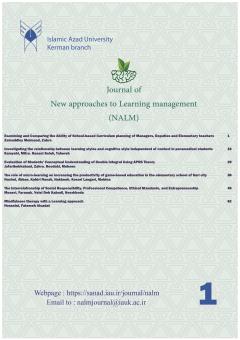The Role of Micro-learning on increasing the Productivity of Game-based education in the Elementary School of Sari City
Subject Areas : Educational Science
Hakimeh Kabirinasab
1
![]() ,
Abbas Nasimi
2
*
,
Abbas Nasimi
2
*
![]() ,
Mobina Kosari Langari
3
,
Mobina Kosari Langari
3
1 - Ph.D Student of Curriculum Planning, Department of Curriculum Planning, Sari Branch, Islamic Azad University, Sari, Iran
2 - Assistant Professor, Department of Educational Sciences, Tonkabon Branch, Islamic Azad University, Tonkabon, Iran
3 - MA Student in Curriculum Planning, Department of Curriculum Planning, Sari Branch, Islamic Azad University, Sari, Iran
Keywords: Microlearning, Education Productivity, Game,
Abstract :
Introduction: This research investigated the effect of micro-learning on increasing the productivity of game-based education in the elementary school of Sari.
Methodology: This research is a quasi-experimental research and the statistical population of the research includes all preschool students of Sari city, which are 2532. Sampling of this research was done as a purposeful sampling method, 30 people were selected (15 people in the experimental group and 15 people in the control group) and were randomly replaced. Game-based education productivity questionnaire was implemented as a pre-test on two groups. The experimental group was exposed to the experiment for 9 sessions weekly for 15 minutes in each session (teaching using the microlearning method) and the control group was exposed to training in the normal way for an hour for 9 sessions weekly. It was included in each meeting and after the end of the meetings, they answered the game-based education productivity questionnaire. Two months after holding and finishing the meetings, the test was conducted again, the data obtained were analyzed using the normal test and the repeated measurement test. Kolmogorov-Smirnov test was used to determine the normality of the data. Levine's test was used to check the homogeneity and homogeneity of variances, analysis of covariance was used to compare the pre-tests and post-tests of the two groups, and to compare the averages of the pre-test and post-test.
Findings: The results of the covariance test showed that the variables of educational clips with an impact factor of 49.12, cartoons with a rate of 67.25, short stories with a rate of 28.29, and book summaries with a rate of 22.97 are effective on increasing the productivity of primary school students in Sari city.
Conclusion: The research showed that micro learning, including educational clips, cartoons, short stories and book summaries, has a positive effect on increasing the productivity of game-based education in the elementary school of Sari city. According to the results of the research, it is suggested to the education administrators to add the micro-learning training program to the primary education and consider this training in their plans for the students.
AlTameemy, F.(2017). Mobile phones for teaching and learning: implementation and students’ and teachers’
attitudes. J Educ Technol Soc. 45:436-451. 10.1177/0047239516659754.
Corbeil, R., & Corbeil, M. E. (2023). Microlearning: The “OG” or Hot New Trend? EDUCAUSE Review.
Ebbinghaus H.(1885). Memory: A Contribution to Experimental Psychology . Teachers College, Columbia
University, New York.
Ebrahimi Dabbagh, Mohammad, and Zafarhidarpour, Mehdi.( 2022). a review of the effects of micro-learning on
the level of learning. Research in experimental science education, volume 1, number 1, 1-8. [In Persian]
Freeman, L. E. (2016). Microlearning, a video series: a sequence of videos exploring the definition, affordances,
and history of microlearning.
Fatah Vajargah, Korosh and Arefi, Saeedeh and Dehghan Saein, Rasul. )1402(. learning wisdom and its effects in
increasing the efficiency of electronic education in schools, the fifth national conference on innovation and research in psychology, law and cultural management, Tehran. [In Persian].
Gabriel Pedro LFM, de Oliveira Barbosa CMM, das Neves Santos CM. (2018). A critical review of mobile
learning integration in formal educational contexts. Int J Educ Technol High Educ. 15. 10.1186/s41239-018-0091-4.
Hug T. (2005). Micro learning and narration: exploring possibilities of utilization of narrations and storytelling
for the designing of “micro units” and didactical micro-learning arrangements. Proceedings of Media in Transition. MIT, Cambridge, MA.
Kang, SH. (2016). Spaced repetition promotes efficient and effective learning: policy implications for instruction.
PIBBS. 6, 3:12-19. 10.1177/2372732215624708.
Khan, M., Pridgen, S., & Nutter-Pridgen, K. L. (2022). The effect of a rich environment with micro learning on
the learning rate and motivation of students' progress. The Journals of Gerontology: Series B, 73(8), 1339-1349.
MacLeod , S, Reynolds MG, Lehmann H.(2018). The mitigating effect of repeated memory reactivations on
forgetting. Nature. 2018, 3:9.
Mayer, R. E. (2001). Dual-Coding Theory. In International Encyclopedia of Education (3rd ed.)
Murre JM, Dros J. (2015). Replication and analysis of Ebbinghaus' forgetting curve . PLoS One.10:e0120644.
10.1371/journal.pone.0120644
Nasiri, Ali& Adib Moradi Langroudi, Arshiya, )2019( .investigation of prominent approaches of implementing
gamification technique as a micro learning tool in integrated and mobile learning environments, the first national mobile learning conference, from idea to practice, Tehran. [In Persian]
Roesler, R. (2017). Molecular mechanisms controlling protein synthesis in memory reconsolidation . Neurobiol
Learn Mem, 142:30-40. 10.1016/j.nlm.2017.04.015
Romanenko, Yulia & Solodovnikova, Ekaterina & Maksimenko, Nadezhda.(2023).
Microlearning as a new method of teaching soft skills to university students. Frontiers in Education.
Sail M. S. (2019). Using Micro-learning on Mobile Applications to Increase Knowledge Retention and WorkPerformance: A Review of Literature. Cureus, 11(8), e5307.
Scott H, Andrew G.(1997). Hum Perform. Order effects in personnel decision making .1997;10:31–46.
Sir wan Mohammed, G., Wakil, K., Sirwan Nawroly, S. (2018). The Effectiveness of Microlearning to Improve
Students’ Learning Ability. International Journal of Educational Research Review.
Yuan X. (2022). Evidence of the Spacing Effect and Influences on Perceptions of Learning and Science Curricula.
Cureus, 14(1), e21201.

